Yamaha MT-10 SP test: Sweden does it good

One year after the release of the MT-10, Yamaha offers a more sophisticated version of its maxisportive maxiroadster: the MT-10 SP. Equipped with a specific color, the dashboard of the R1 and – above all! – electronic Ohlins suspensions of the R1M, can it make you crack ? Site tested it !
MT-10 SP test page 3 – Technical point
Engine
Coming from the last generation of R1, the CP4 (small name given by Yamaha to its inline 4-cylinder with Crossplane tuning) of the MT-10 SP is exactly the same as that of the standard version … slightly revised this year , although it complied with the Euro4 emissions standard from its release in 2016.
The 2017 MT-10 models – with or without "SP"! – indeed benefit from a new engine mapping "which offers smoother acceleration at low speed as well as at high speed, in order to ensure more balanced performance", ensures Yamaha.
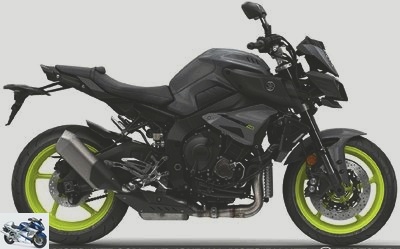
In addition, like the new MT-09, the MT-10 now adopts the quickshifter (QSS) as standard, which allows upshifting without touching the clutch. To lower them, however, the left hand is always requested, as is the case on the R1. The anti-dribble clutch always takes care in the event of a sudden downshift.
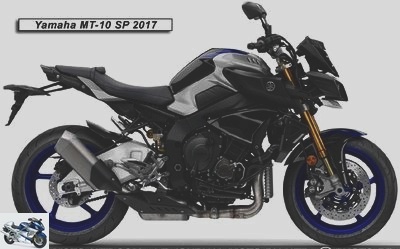
"By momentarily canceling the drive torque when it detects a shift upshift, the QSS system guarantees even more breathtaking acceleration", describes the manufacturer. Bald people will have the hair – arms, torso or shoulders! – all spiky … Word of MNC !
The rest of the engine specifications are unchanged from the MT-10 launched last year. As a reminder, here is what the Journal moto du Net indicated in the technical point of the original model. See you further down in the cycle part for those who already know by heart the guts of the 4-cylinder…
Deradicalization…
Power decreases on the roadster, dropping from 200 hp on the R1 to 160.4 hp, to the benefit of availability and mid-revs. By the way, the torque also decreases slightly (111 Nm against 112.4), probably due to the transition to the most recent standards (the MT-10 is Euro4 approved, unlike the R1).

Among the changes made to "de-radicalize" the MT-10, 40% affect the engine. These include the completely modified intake circuit with a larger airbox (12 liters against 10.5 on the R1) and the redesigned and reconfigured exhaust and power system. New forged pistons, a new cylinder head and a new balance wheel also appear..
By the way, all these improvements allow Yamaha to contain costs by leaving aside the high-end materials and technologies developed for the Superbike, such as its titanium connecting rods (steel on the MT-10), the intake horns to variable lengths or its cylinder head covers and magnesium oil pan.

Other common tips for deflating the 4-legged: the maximum speed is lowered (12,000 rpm against 14,000 on the R1) and the compression ratio loses a point, going to 13: 1 on the R1 to 12: 1 on MT. Finally, the final chain transmission is shortened to boost the relaunches, while the injection – managed by an electronic accelerator, like the R1 – is reconfigured..
The crankshaft and the flywheel are also heavier in order to give roundness to the engine but for the rest, nothing changes: the block of 998 cc retains its super-square dimensions (79 x 50.9 mm) and its distribution by double ACT. On the other hand, the superb aluminum screws of the Superbike give way to steel screws, heavier certainly but also less expensive. !
Cycle part
Until then specific to the R1M, the electronically adjustable Ohlins suspensions (ERS) are fitted to this new MT-10 SP, replacing the fully adjustable Kayaba 43mm inverted fork and the separate cylinder mono-shock absorber, also fully adjustable. (including in high and low speed compression) that the MT-10 "quite simply" had stolen from the R1 "quite simply".
The suspension control unit (SCU) analyzes data from a series of sensors and calculates the most suitable compression and rebound damping settings for the day’s conditions, while the stepper motors in the system instantly make the necessary adjustments to ensure optimal suspension setup, "Yamaha reminds us..
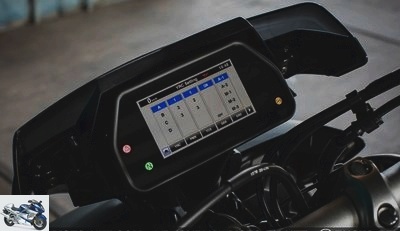
Two automatic modes are available to the pilot: "the A1" sport "is optimized for performance on winding roads and on circuits, while the A2" touring "is more geared towards comfort and safety on expressways and in the city", specifies Ohlins.
Three other modes (M1, 2 or 3) allow the user – informed – to adjust his fork and its shock absorber himself, as he could do with conventional elements … but without tools, by simply "clicking" on the commodos keys.
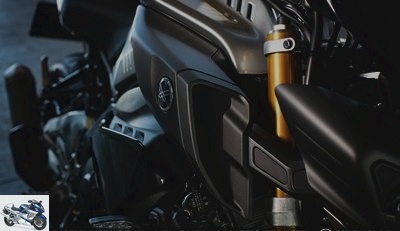
The third shock absorber, steering (!), Is kept in order to guard against possible steering: the cocktail of the maxiroadster composed of 160 hp, 1400 mm of wheelbase (5 mm less than on the very short R1!) And of 210 kg fully loaded (11 kg more than the Superbike) actually remains slightly unstable when accelerating in the first three gears. It is advisable to go as far as possible to keep the front wheel on the ground…
Closely derived from those of the R1, the aluminum perimeter frame and swingarm of the MT-10 are carried over to the SP. The MT-10’s steel rear buckle (magnesium on the R1) is kept as it is on the top-of-the-range version: it still incorporates the semi-rigid luggage mounts available in the accessory section. Hyper sporty, the MT-10 SP is also super practical !
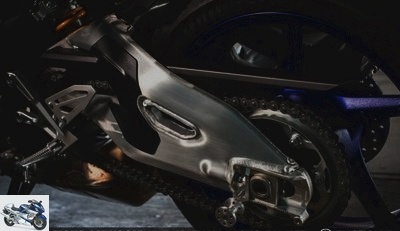
As on the original MT-10, the magnesium rims of the R1 are replaced by heavier but less expensive aluminum components. Likewise, the sports car’s aluminum tank gives way to a tank with the same capacity (17 liters) but made of steel..
Braking remains entrusted to 4-piston radial calipers and 320 mm discs (220 mm at the rear). Disappeared during the transfer R1 / MT-10, the braided hoses are not making a comeback on the classy SP. Too bad, on a machine invoiced for 16,000 euros (sorry, 15,999 €) … Similarly, the compulsory ABS (but disconnectable) does not find its front-to-rear coupling function introduced on the R1.
Electronics and piloting aids
Inaugurated two years ago by certain motorcycle manufacturers on their most charismatic models (Yamaha R1 or BMW K1600GT in particular), dashboards are currently tending to become more democratic (Triumph Street Triple RS and KTM road range 2017 for example).
Stitched to the R1 – with or without "M" – precisely, the TFT screen of the SP displays an impressive amount of information. A little too much: the secondary data (like the consos or the clock) are written in small and can only be deciphered at a quick glance by fighter pilots, certified 10/10 in both eyes !
The SP does not differ in any way from the standard MT-10 as regards the engine electronics and the steering aids accessible to the handlebars: it has the same injection maps (renamed 1, 2 and 3, from the more dynamic at the softer) and traction control (TCS) also adjustable on three levels and can be deactivated.
The high-end model of Yamaha‘s "Hypernaked" therefore ignores the inertial unit (the famous IMU) which provides the best sports cars currently on the market, starting with the R1, devilishly gentle and effective interventions. !
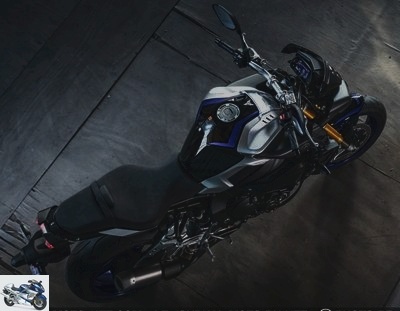
The MT-10 SP driver therefore does not benefit from the magical rear tire lateral slip control (SCS) is deprived of the very fine anti-wheeling, and will do without the assistant at the start. Concretely, these cutting-edge tools will hardly be lacking on the road or during "quiet" track days … But they could be lacking during lively discussions in front of owners of Tuono V4 1100 RF or S1000RR "full options" !
Like the MT-10, the SP version still includes the speed regulator as standard, which may become essential in the years to come … Unfortunately, Yamaha does not offer additional points for the license in its accessories. !
Related articles
-
Yamaha MT-10 SP test : Sweden does it good A year after the release of the MT-10, Yamaha offers a more sophisticated version of its maxisportive…
-
Yamaha MT-10 test: killer face and athlete’s body The first Japanese manufacturer to have transformed its Superbike into an elite roadster with the FZ1…
-
2017 Yamaha YZF-R6 test: no, the Supersport is not dead Yamaha is the only major motorcycle manufacturer to keep its 600 cc sports car in its catalog in…
-
Yamaha Niken test: trying the three-wheeled motorcycle is taming it ! For more than ten years, Yamaha engineers have been racking their brains to offer a…
-
Roadster – Yamaha MT-09 SP test: the one we SPEED! – MT-09 SP test page 3: Technical point
Yamaha MT-09 SP test: the one we Sought ! The Yamaha MT-09, one of the stars of the French motorcycle market, never ceases to enchant bikers eager for…
-
Roadster – Test Yamaha MT-09 2017: mult (r) iples pleasures! – Page 3 – Technical point MT-09 2017
2017 Yamaha MT-09 review: mult (r) iples pleasures ! Having become a bestseller in just four years, the Yamaha MT-09 is full of positive developments for…
-
Speed Triple RS test: the Triumph roadster raises the tone and the sound in 2018 Only two years after its last update, the Speed Triple benefits from…
-
Tmax 2017 SX and DX test: Yamaha gives (sells) its maximum ! Yamaha is launching its new Tmax 530 2017, available in three models: the standard, the…
-
2017 Suzuki V-Strom 1000 XT test: a super cost ! The Suzuki V-Strom 1000 , relaunched in 2013 after a career suspension in 2008 due to Euro 3 standards,…
-
Z900RS test: the new neo-retro Kawasaki Zed, zen and zealous Kawasaki is back in the neo-retro segment with a brand new motorcycle: the Z900RS! Site was…